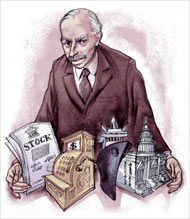 Lately, I’ve become increasingly skeptical that the steps being taken in Washington are close enough to the source of our economic problems to be successful. A recent New York Times article reflects on the new consumer aid program, for example. The TALF program (Term Asset-Backed Securities Loan Facility) will lend $200 million to private investors who will buy securities backed by auto loans, credit cards, etc.
Lately, I’ve become increasingly skeptical that the steps being taken in Washington are close enough to the source of our economic problems to be successful. A recent New York Times article reflects on the new consumer aid program, for example. The TALF program (Term Asset-Backed Securities Loan Facility) will lend $200 million to private investors who will buy securities backed by auto loans, credit cards, etc.
In theory, this will keep credit flowing freely from lenders to borrowers but I’m dubious of this trickle-down expectation. If Keynes is right that the locus of economic turbulence is insufficient demand, there are just too many places “twixt the cup and the lip” for these incentives to go awry and for the stimulating effect to dissipate.
Take a look at Gregory Mankiw’s (Harvard professor of economics) primer on the economic theories of John Maynard Keynes here to refresh your memory on some of his tenets. My earlier post about the dearth of new financing validates this trend for TARP and other programs and there is no reason to be encouraged that it will improve . . . not to mention the more restrictive credit qualifications making more people less eligible for the funds meant to be lent . . . and that lower rates don’t help when unemployment rises.
We need to get these programs a lot closer to the bone if we expect any real relief anytime soon.


